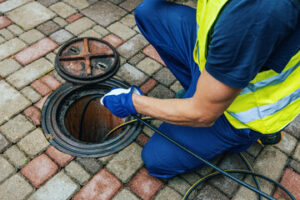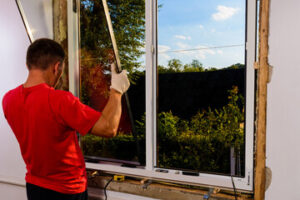Damaged sewer lines can create serious issues for your property. If your pipes are cracked, leaking, or clogged, you must hire a professional for a sewer line repair as soon as possible. Contact Clearwater FL Plumber for professional help.

Your plumber can fix the problem in a few different ways, including traditional excavation and trenchless repair methods. Depending on the cause of the problem, your plumber may recommend a specific process.
The beautiful trees in your yard provide beauty and shade, but they can also cause problems if they creep too close to your home’s sewer line. Roots are attracted to the liquid sewage flowing in your underground pipes because it’s rich in nutrients and moisture. Over time, they can cause tough clogs and degrade the condition of your pipes. This can result in expensive repairs.
One of the most common causes of sewer line backups is root infiltration. Tree roots can infiltrate your sewer lines through joints, cracks, and other weak spots. These roots can then grow and latch on to the insides of the pipes, causing them to tangle and restrict flow. In severe cases, this can lead to a complete blockage of your sewer line, which can affect your entire plumbing system.
Fortunately, you can take precautions to prevent this issue. The best way to protect your home’s sewer line from infiltration by tree roots is to have a professional install an effective barrier on your property. A plumber can use chemical solutions or plywood to keep the roots away from your pipes. If the problem already exists, a plumber can use advanced methods like hydro jetting to clear out existing roots and prevent them from growing back.
In addition to preventing root infiltration, regular inspections can help spot signs of the problem early on. A plumber can use a camera to check the condition of your pipes and identify any areas that might need reinforcement or repair. This can reduce the risk of a root invasion and save you money in the long run.
The most important thing to remember is that it’s not always easy to detect problems with your sewer line. The best way to protect your home and your family’s health is to contact a professional plumber as soon as you notice any signs of trouble. A qualified plumber will be able to perform an inspection and recommend the best course of action for your sewer line repair. By addressing the issue promptly, you can avoid costly and hazardous consequences.
Rust and Corrosion
Corrosion is one of the main problems for metal surfaces, especially those in pipes. The oxidation of metal can cause severe damage to pipes and even affect water quality. It’s important to take action when you notice any signs of rust or corrosion in your plumbing pipes. A professional plumber can assess the situation and recommend a course of action to correct it.
The most common form of corrosion in home plumbing is iron or steel pipe corrosion. Rust happens when oxygen comes in contact with iron and other metals, triggering a chemical reaction that eats away at the surface of the metal. This can lead to holes in the pipes, which will inevitably clog them over time.
This problem is more prevalent in older homes, but can affect any type of metal pipe. Typically, older homes will have iron cast or galvanized steel pipes in them. These are more susceptible to corrosion than newer pipes made of copper or PVC. This is because iron corrodes faster than other metals.
When it comes to corroded pipes, the most common symptoms are discolored water and a bad smell or taste in your drinking water. If you notice that your drinking water has a reddish or orange color to it, this is a sign of corroded iron pipes in your house. It can also lead to low water pressure and damage your appliances over time.
Corroded pipes can also leak, which will require professional help to repair and replace them. If the leaking is not repaired quickly, it can lead to flooding, mold growth and other serious issues in your home.
You can prevent corroded pipes from occurring by taking a few simple precautions. A regular schedule of cleaning and maintenance can go a long way in keeping your pipes in good condition. Additionally, you can install a water softener in your home to help reduce the amount of corrosive minerals in your drinking water.
Clogs
If you’ve ever dealt with a clogged drain, you know that it can be a nuisance and in some cases a health hazard. But imagine if a damaged sewer line caused all your drains to back up at once! That’s a situation you definitely want to avoid, as raw sewage can cause serious and expensive damage to your home.
When a clog affects all your household drains, it’s likely due to a blocked sewer line. Thankfully, a plumbing expert can diagnose the problem and fix it before it gets worse.
The most common culprit for a clogged sewer line is tree roots. The warm and moist conditions inside the pipes attract tree roots, which slowly grow into cracks and loose joints until they reach a blockage point. Usually, the first sign is when multiple drains start to run slow at once. Then, toilets on the lower level of your house may begin to overflow when you flush them. Eventually, the problems will move up to your main floor bathrooms and then your kitchen drains.
You can help to prevent clogs by keeping an eye out for what goes down your drains. Items like tampons, condoms, paper towels, and personal care wipes should never be flushed down commodes. These products collect grease and other materials, which clump together to create “fatbergs” that clog lines.
It’s also important to use a garbage disposal regularly and keep your yard free of debris. A clogged sewer line will not only result in backups but can also lead to a broken pipe. If the line breaks, sewage can flood your basement and cause serious health and safety issues for your family.
If you suspect a sewer line clog, the first step is to find your drain clean-out. This is a drain fitting near the street that has a round threaded plug with a square, nut-like stub on the end. Unscrewing and removing the plug will reveal the condition of your drain line. If it’s clear, you probably only need a routine cleaning or snaking service. If there is a clog, your plumber will need to dig up and replace the section of line.
Poor Maintenance
The pipes that carry wastewater out of your home are essential for the health and well-being of your family. Damage to these lines can cause foul odors, messy yards, and unsafe living conditions. The good news is that, with proper maintenance, these problems can be prevented.
Your drains work hard to move water in and out of your home, but they can’t always do so effectively if the line is clogged with hair, dirt, or other debris. If you have a clogged drain that can’t be remedied by a plunger or bottle of drain cleaner, it may be time for a professional sewer repair.
Clogged drains can also increase the humidity in your home, making it more attractive to moisture-loving pests like termites and mold. A professional plumber can install a high-efficiency dehumidifier to control the problem and keep your house comfortable.
A common cause of clogged drains is tree roots. They can infiltrate the pipes in search of water and nutrients, leading to clogs and breakage. To minimize this risk, plant trees away from your sewer lines and regularly inspect them for signs of root intrusion.
It’s also important to avoid dumping anything down the drain that isn’t organic waste or human waste. Large items such as paper towels, feminine products, and grease can cause blockages, while cleaning products and chemical toilet bowl cleaners can wear down the pipes and lead to corrosion or leaks.
Sewer lines can’t be expected to last a lifetime, but there are steps you can take to extend their lifespan and prevent costly repairs. The most effective approach is proactive maintenance, including inspections and the use of a snake to clear out small blockages before they grow into major ones.
While some parts of the plumbing system are the responsibility of homeowners, such as clogged sink drains, problems with the sewer line are usually the city’s responsibility. These issues can be difficult and expensive to fix, and can even impact the entire community.
When it comes to repairing and replacing your sewer line, there are many different options available, ranging from pipe bursting to trenchless technology methods. The best solution will depend on the extent of the damage and the length of the line. In many cases, a complete sewer line replacement will be necessary.
